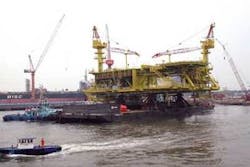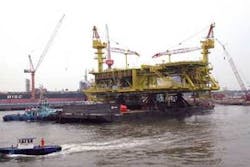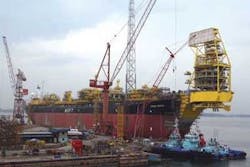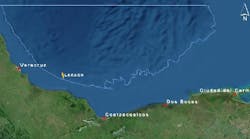The Malaysia Marine Heavy Engineering yard in Pasir Gudang, Johor, Malaysia, is changing focus and making improvements to meet the region’s growing deepwater needs.
MMHE, formerly known as Malaysia Shipyard & Engineering Sdn. Bhd, rebranded itself in May 2005 and now is a wholly owned subsidiary of MISC Berhad. One major MISC Berhad shareholder is Malaysia’s national oil company, Petronas.
Wan Yusoff Wan Hamat, managing director/CEO of MMHE, says the rebranding is only one component of a general re-vamping of the yard, its focus, and its capabilities. The end goal, Wan Yusoff says, is to expand MMHE’s capacity and proficiency to position it as the yard of choice for deepwater production systems for the region.
Changing focus
“Recently,” Wan Yusoff says, “we have refocused ourselves into three areas: marine repair, conversion, and engineering and construction (E&C).
The conversion component, which includes jumboization works, makes up a fair amount of the yard’s work. Though MMHE has carried out repair work for over three decades, the new focus is energy, says Wan Yusoff. MMHE now specializes in repair work on tankers, drillships, jackups, semisubmersibles, and drill tender barges. Another component of the yard’s energy focus is LNG carriers, as MISC Bhd is the biggest LNG fleet owner in the world.
The third area of specialization at MMHE is E&C. From its early days of fabricating jackets, living quarters, and topsides, mostly for shallow water, MMHE now is aggressively moving into deepwater field projects.
“The yard is now geared for meeting the requirements for deepwater production,” Wan Yusoff says.
MMHE is building its capabilities to construct deepwater production systems, including spars and semisubmersibles, so it can meet the region’s construction and conversion needs. “The yard is also constructing drill tender barges, a niche market where the yard can be very competitive,” Wan Yusoff says.
Diving into deepwater
The yard made its first foray into deepwater when it won the bid to build its first spar.
“Kikeh was an interesting project because it was our first spar, and as a result, it brought with it many firsts,” Wan Yusoff says. MMHE worked closely with Technip, which won the EPIC contract for the spar, to become competent to build the spar in Malaysia. The Kikeh spar is the first spar Technip built at a location other than Pori, Finland.
Though the yard lacked spar experience, it was experienced in building hulls in-house because of its extensive shipbuilding background.
“We worked with Technip to bring in expertise from Finland. Since gaining that expertise required significant cooperation, MMHE personnel went to Pori for training, and Technip engineers set up an office at the MMHE yard to oversee construction. It was a successful technology transfer,” Wan Yusoff says.
Building the spar required more than a technology transfer, however. It required MMHE to modify the yard.
“We set up additional facilities, including skidding tracks, the jacking system, covered sheds, and more workshops to support the spar construction,” Wan Yusoff says. “These modifications will allow MMHE to build the next spar more easily.”
Converting FSOs/FPSOs
MMHE’s part of the spar construction project ended with the spar’s departure from the yard, which took place according to plan.
MMHE also built the topsides for the spar dry-tree unit, and, likewise, won the conversion contract for theKikeh FPSO.
The FPSO conversion is a project MMHE undertook in conjunction with MDFT, a joint venture formed by MISC and Single Buoy Moorings. MDFT is responsible for the design part of the project, while MMHE handles fabrication of all the modules and integration. The yard fabricated and installed the turret and carried out modifications on the FPSO.
The vessel is scheduled to sail at the end of March, Wan Yusoff says, and work is progressing toward that end, even with the other FSO conversions in the yard at the same time.
- Maximum throughput
120,000 b/d oil, 150 MMcf/d of gas - Gas injection
135 MMcf/d - Water injection
260,000 b/d - Vessel size
273,000 dwt - Storage capacity
2 MMbbl - Water depth capability
1,350 m (4,429 ft) - Number of risers
9 (4 future)
Capacity is one of the yard’s selling points, Wan Yusoff says. Another is MMHE’s ability to perform a broad range of construction and conversion work.
“Our yard is offering a one-stop shop for FPSO conversion. Not many yards can do the full project,” Wan Yusoff says. “You can get the turret here, the topside modules, even the vessel itself.”
Looking forward
The ability to build bigger and heavier structures is essential if the MMHE yard is to compete for deepwater production systems. That is why the company is optimizing the use of its resources.
The yard has mobilized an optimization team to study how to best use the yard layout and to determine what facilities will be needed.
MMHE already has begun making significant changes. “There is a new 400 m x 80 m (1,312 ft x 262 ft) workshop that will be completed in 3Q 2007,” Wan Yusoff says. The workshop will be the biggest workshop in Asia and will significantly increase throughput in the yard.
With new deepwater developments coming up, MMHE is working on expanding its load-out bulkheads to accommodate greater tonnage and is considering dredging to give greater depth at quayside, Wan Yusoff says. The work should be complete by 2009.
With theKikeh spar behind it, MMHE has added to its experience, but future fields will have different construction needs, and MMHE wants to be ready.
“Subsequent fields will come up, so we have to develop our capabilities as we go along,” Wan Yusoff says.
Deepwater hub
The Kikeh field, which comes onstream later this year, will be the first deepwater development offshore Malaysia, but it will not be the last. Shell also has a deepwater discovery offshore Malaysia called Gumusut that likely will be developed.
In fact, with the number of deepwater discoveries increasing, Petronas has announced its desire for Malaysia to become a regional deepwater hub.
“That means within Malaysia we will be able to do everything required for deepwater exploration and construction,” Wan Yusoff says. And MMHE wants to be ready.
According to Wan Yusoff, the yard is not alone in making its preparations for deepwater operations. “A lot of companies have set up shop here,” he adds, noting that SBM has opened an office and that FMC and Cameron have built facilities. Early this year, APL and Bluewater opened offices in Kuala Lumpur as well. “Big things are happening,” he says.
Local content, foreign competition
One concern for companies competing for work in Malaysia is meeting the local content requirements. For Malaysia-based MMHE that is not a concern.
“The majority of our employees are locals,” Wan Yusoff says, “though we do have some foreigners. We bring in engineers from the Philippines, Indonesia, and India, but the bulk of our employee base is Malaysian.”
Dealing with the personnel issue is one thing. Dealing with regional competition is another. Yards appear to be popping up all over China, and they seemingly are competitive from the outset. “Anybody who has a beach front is building a yard there,” Wan Yusoff quips.
Though the new yards are quite competitive in terms of shipbuilding, Wan Yusoff says, in terms of FSO and FPSO conversions and more advanced yard work, they are not yet in the running. Wan Yusoff sees this as a short-term situation, however, noting, “In time to come, you never know.”
Undeniably, there is a learning curve that the Chinese are working to overcome, but they may not be working alone. According to Wan Yusoff, a lot of Western countries are helping the Chinese yards to develop.
The primary consideration for the immediate future, according to Wan Yusoff, is HSE. “In the marine and oil & gas industry, safety is very critical. It is our No. 1 consideration.”
MMHE places considerable emphasis on safety, investing continually in safety programs and safety training. Wan Yusoff points to the success of theKikeh spar as evidence of the safety level at the MMHE yard. Spar construction was executed without a serious incident.
While the focus recently has been on Chinese yards, MMHE recognizes that Vietnam is another serious competitor. And the Vietnamese yards are further ahead in terms of capabilities, Wan Yusoff says. “The Vietnamese yards are already cornering some of the FPSO business.”
A look at the MMHE order book, however, indicates that foreign competition is not hurting business. The yard has orders into 2010, but has not yet reached its full capacity.
“We will be able to take on more projects by the middle of 2008,” Wan Yusoff says. “But now, we have to be very selective because our books are nearly full.”







